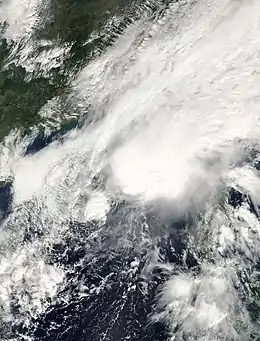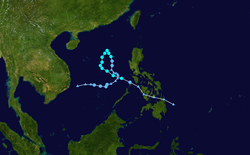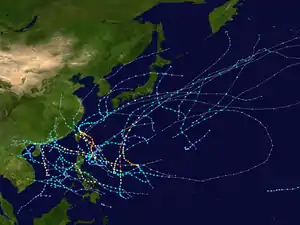Tropical Storm Maysak (2008)
Severe Tropical Storm Maysak, known in the Philippines as Tropical Storm Quinta-Siony, was recognised as the 19th tropical storm by the Japan Meteorological Agency. It was also recognised as the 24th tropical depression and the 22nd tropical storm by the Joint Typhoon Warning Center of the 2008 Pacific typhoon season.
| Severe tropical storm (JMA scale) | |
|---|---|
| Tropical storm (SSHWS) | |
 Tropical Storm Maysak shortly after peak intensity on November 9 | |
| Formed | November 6, 2008 |
| Dissipated | November 14, 2008 |
| Highest winds | 10-minute sustained: 95 km/h (60 mph) 1-minute sustained: 110 km/h (70 mph) |
| Lowest pressure | 985 hPa (mbar); 29.09 inHg |
| Fatalities | 30 total |
| Damage | None |
| Areas affected | Philippines |
| Part of the 2008 Pacific typhoon season | |
Meteorological history

On November 5, 2008, a tropical disturbance formed in the Philippine Sea to the northeast of Zamboanga in the Philippines.[1] Later that day whilst the disturbance moved towards the north-west, the Joint Typhoon Warning Center assessed the disturbances chances of forming into a significant tropical cyclone within 24 hours as "Poor".[1] Early the next day as the disturbance was moving closer to the Philippines, PAGASA designated the disturbance as Tropical Depression Quinta.[2] Later that day the JTWC upgraded the disturbances chances of becoming a significant tropical cyclone to "Fair" and then to "Good" as they released a Tropical Cyclone Formation Alert on the developing disturbance.[3][4] The Japan Meteorological Agency then designated the disturbance as a minor tropical depression, at the same time the JTWC designated the tropical depression as 24W.[5][6]
On November 7 after the JMA had designated the minor tropical depression as a full tropical depression, the JTWC and the JMA upgraded the depression to a tropical storm with the JMA assigning the name Maysak.[7][8][9] The next day PAGASA released their final advisory on tropical storm Quinta (Maysak) as it had moved out of PAGASA's area of responsibility, this came as both the JTWC and the JMA reported that Maysak had reached its peak wind speeds of 60 mph (95 km/h) 10-Min sustained & 70 mph (110 km/h) 1-Min sustained.[10][11][12] This meant that the JMA considered Maysak to be a severe tropical storm at its peak whilst on the Saffir-Simpson Hurricane Scale Maysak was considered to be a tropical storm.[12]
Later that day Maysak recurved and started moving towards the south towards PAGASA's area of responsibility. The next day before Maysak re-entered PAGASA's area of responsibility, the JMA reported that Maysak had weakened into a tropical storm and then into a tropical depression, and released their final full advisory on Maysak.[13][14] However the JTWC were reporting at this time that Maysak was still a tropical storm.[11] Maysak then moved back into PAGASA's area of responsibility later that day, at this time PAGASA thought that Maysak was still a tropical storm.[15] The JTWC downgraded Maysak to a tropical depression and released their final advisory early on November 10.[16] PAGASA also downgraded Maysak to a tropical depression at this time however they kept issuing warnings until early the next afternoon when they released their final advisory on Quinta.[17]
On November 12, PAGASA started to reissue advisories on Quinta, however they renamed Quinta as Siony.[18] The JMA were also still monitoring Siony as a minor tropical depression at this time, whilst the JTWC assessed Maysak's remnants chances of regenerating into a significant tropical cyclone as fair.[19][20] Later that day the JTWC upgraded the remnants chances of regenerating as good and released a tropical cyclone formation alert.[21] Later that day PAGASA released their final advisory on tropical depression Siony as it had moved out of their area of responsibility and was moving towards Vietnam in the west.[22] Late the next day the JTWC cancelled the tropical cyclone formation alert as they had reassessed Maysak chances of forming into a significant tropical cyclone within 24 hours as poor.[23] Early the next day the JMA released their final advisory on tropical depression Maysak whilst later that morning the JTWC declared that Maysak had dissipated.
Preparations and Impact
Philippines
As PAGASA declared that Tropical Depression Quinta had formed, they put Public Storm warning signal No.1 up for parts of Luzon, Visayas, Mindanao.[2] This meant that wind speeds of 30–60 km/h were expected within 36 hours. Later that day PAGASA put some more areas of Luzon under Signal 1 and cancelled the signal over parts of Mindanao[24] Later on November 6 PAGASA kept revising the areas under Signal No.1 in Visayas & Luzon.[25][26] PAGASA then cancelled all signals for Visayas Later that day as Quinta moved away from the Philippines.[27] Early the next day PAGASA cancelled all off the signals for Luzon as they released their first final advisory on Qunita.[10]
On November 12, the Philippine National Disaster Coordinating Council (NDCC) reported that over 4800 people were affected by tropical storm Maysak.[28] The NDCC reported that a total of 92 homes were either partially or totally destroyed in the Philippines.[28] Sixteen of the municipalities in the Philippines reported power interruptions from November 6 until November 7.[28] In total 19 people were killed by Maysak and 14 people injured.[28]
Vietnam
The remnants of Maysak lead to flooding rains in Vietnam which left at least 11 people dead. Flood waters in Ho Chi Minh City were estimated to be at least a metre (3 ft) deep.[29]
See also
- Typhoon Wutip (2013) (a.k.a. Paolo in the Philippines -a major typhoon that formed in the South China Sea.
- Tropical Storm Podul (2013) -(a.k.a. Zoraida in the Philippines)- brought more misery to the Philippines after Typhoon Haiyan.
- Severe Tropical Storm Tapah (2019) (a.k.a. Marilyn or Nimfa) -Tapah was also given two names by PAGASA, Marilyn and later Nimfa, which caused flooding in the Philippines after a significant monsoon event which was enhanced by previous storms.
References
- "JTWC ABPW10 05-11-08 18z". Joint Typhoon Warning Center. Archived from the original on October 5, 2008. Retrieved 2008-11-05.CS1 maint: unfit URL (link)
- "PAGASA Warning 06-11-08 00z". Philippine Atmospheric, Geophysical and Astronomical Services Administration. Archived from the original on May 7, 2008. Retrieved 2008-11-08.CS1 maint: unfit URL (link)
- "JTWC ABPW10 06-11-08 06z". Joint Typhoon Warning Center. Archived from the original on October 5, 2008. Retrieved 2008-11-06.CS1 maint: unfit URL (link)
- "JTWC Tropical Cyclone Formation Alert 06-11-08 15z". Joint Typhoon Warning Center. Archived from the original on October 14, 2008. Retrieved 2008-11-06.CS1 maint: unfit URL (link)
- "JTWC Tropical Cyclone Warning 06-11-08 21z". Joint Typhoon Warning Center. Archived from the original on October 14, 2008. Retrieved 2008-11-06.CS1 maint: unfit URL (link)
- "JMA Tropical Cyclone WWJP25 Warning 06-11-08 18z". Japan Meteorological Agency. Archived from the original on October 10, 2008. Retrieved 2008-11-06.CS1 maint: unfit URL (link)
- "JMA Tropical Cyclone Advisory 07-11-08 00z". Japan Meteorological Agency. Archived from the original on 2008-10-14. Retrieved 2008-11-07.
- "JTWC Tropical Cyclone Warning 07-11-08 03z". Joint Typhoon Warning Center. Archived from the original on October 14, 2008. Retrieved 2008-11-07.CS1 maint: unfit URL (link)
- "JMA Tropical Cyclone Advisory 07-11-08 06z". Japan Meteorological Agency. Archived from the original on 2008-10-14. Retrieved 2008-11-07.
- "PAGASA Warning 07-11-08 03z". Philippine Atmospheric, Geophysical and Astronomical Services Administration. Archived from the original on May 7, 2008. Retrieved 2008-11-08.CS1 maint: unfit URL (link)
- Joint Typhoon Warning Center. "JTWC Best Track: Maysak". Naval Research Laboratory. Retrieved 2008-11-14.
- "JMA Tropical Cyclone Advisory 08-11-08 12z". Japan Meteorological Agency. Archived from the original on 2008-10-14. Retrieved 2008-11-08.
- "JMA Tropical Cyclone Advisory 09-11-08 09z". Japan Meteorological Agency. Archived from the original on 2008-10-14. Retrieved 2008-11-09.
- "JMA Tropical Cyclone Advisory 09-11-08 12z". Japan Meteorological Agency. Archived from the original on 2008-10-14. Retrieved 2008-11-09.
- "PAGASA Warning 09-11-08 21z". Philippine Atmospheric, Geophysical and Astronomical Services Administration. Archived from the original on May 7, 2008. Retrieved 2008-11-09.CS1 maint: unfit URL (link)
- "JTWC Tropical Cyclone Warning 10-11-08 03z". Joint Typhoon Warning Center. Archived from the original on October 14, 2008. Retrieved 2008-11-10.CS1 maint: unfit URL (link)
- "PAGASA Warning 11-11-08 15z". Philippine Atmospheric, Geophysical and Astronomical Services Administration. Archived from the original on October 14, 2008. Retrieved 2008-11-11.CS1 maint: unfit URL (link)
- "PAGASA Warning 12-11-08 09z". Philippine Atmospheric, Geophysical and Astronomical Services Administration. Archived from the original on May 7, 2008. Retrieved 2008-11-12.CS1 maint: unfit URL (link)
- "JMA Tropical Cyclone WWJP25 Warning 12-11-08 12z". Japan Meteorological Agency. Archived from the original on October 10, 2008. Retrieved 2008-11-12.CS1 maint: unfit URL (link)
- "JTWC ABPW10 12-11-08 06z". Joint Typhoon Warning Center. Archived from the original on October 5, 2008. Retrieved 2008-11-12.CS1 maint: unfit URL (link)
- "JTWC Tropical Cyclone Formation Alert 12-11-08 11z". Joint Typhoon Warning Center. Archived from the original on October 14, 2008. Retrieved 2008-11-12.CS1 maint: unfit URL (link)
- "PAGASA Warning 12-11-08 21z". Philippine Atmospheric, Geophysical and Astronomical Services Administration. Archived from the original on May 7, 2008. Retrieved 2008-11-12.CS1 maint: unfit URL (link)
- "JTWC Tropical Cyclone Formation Alert Cancellation 13-11-08 20z". Joint Typhoon Warning Center. Archived from the original on October 14, 2008. Retrieved 2008-11-13.CS1 maint: unfit URL (link)
- "PAGASA Warning 06-11-08 03z". Philippine Atmospheric, Geophysical and Astronomical Services Administration. Archived from the original on May 7, 2008. Retrieved 2008-11-08.CS1 maint: unfit URL (link)
- "PAGASA Warning 06-11-08 09z". Philippine Atmospheric, Geophysical and Astronomical Services Administration. Archived from the original on May 7, 2008. Retrieved 2008-11-08.CS1 maint: unfit URL (link)
- "PAGASA Warning 06-11-08 15z". Philippine Atmospheric, Geophysical and Astronomical Services Administration. Archived from the original on May 7, 2008. Retrieved 2008-11-08.CS1 maint: unfit URL (link)
- "PAGASA Warning 06-11-08 21z". Philippine Atmospheric, Geophysical and Astronomical Services Administration. Archived from the original on May 7, 2008. Retrieved 2008-11-08.CS1 maint: unfit URL (link)
- "Effects of tropical storm Qunita (Maysak) on the Philippines" (PDF). Philippine National Disaster Coordinating Council. 2008-11-12. Archived from the original (PDF) on 2011-05-30. Retrieved 2008-11-14.
- "Floods kill 11 in central and southern Vietnam". Colombian News. Retrieved 2008-11-16.
External links
| Wikimedia Commons has media related to Tropical Storm Maysak (2008). |
- JMA General Information of Severe Tropical Storm Maysak (0819) from Digital Typhoon
- JMA Best Track Data of Severe Tropical Storm Maysak (0819) (in Japanese)
- JTWC Best Track Data of Tropical Storm 24W (Maysak)
- 24W.MAYSAK from the U.S. Naval Research Laboratory
